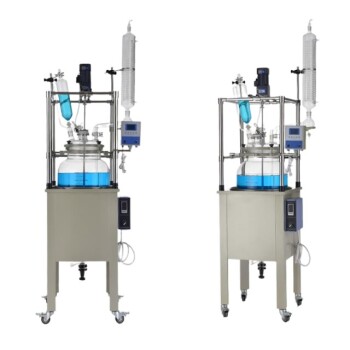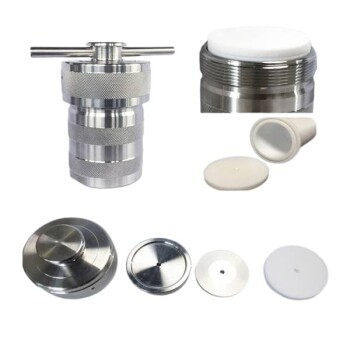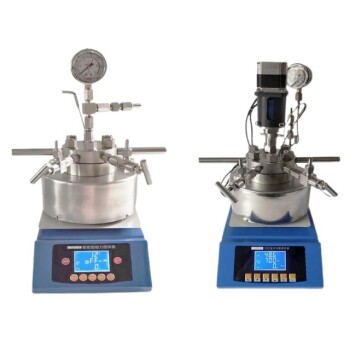A jacketed reactor is a specialized vessel used in chemical processes to control the temperature of reactions. It consists of an inner core where the reaction occurs and an outer jacket that circulates a heating or cooling fluid to regulate the temperature. These reactors are commonly made of materials like glass or stainless steel, depending on the application, and are widely used in laboratories and pilot plants. Jacketed reactors can have single or double jackets, with double jackets offering additional insulation for precise temperature control. They are essential for scaling up reactions, improving product quality, and ensuring consistent results in synthetic processes.
Key Points Explained:

-
Definition and Purpose of a Jacketed Reactor:
- A jacketed reactor is a double-walled vessel designed to control the temperature of chemical reactions.
- The inner vessel (core) holds the reactants, while the outer jacket circulates a heating or cooling fluid to regulate the reaction temperature.
- This design ensures precise temperature control, which is critical for optimizing reaction conditions, improving product quality, and scaling up processes.
-
Components of a Jacketed Reactor:
- Inner Vessel: Typically made of materials like borosilicate glass, stainless steel, or other metals, depending on the application. The inner vessel is resistant to thermal shock and chemical corrosion, ensuring durability and safety.
- Outer Jacket: Surrounds the inner vessel and provides a space for circulating the heating or cooling medium. In double-jacketed systems, an additional outer layer provides vacuum insulation for enhanced temperature control.
- Heat Transfer Medium: Commonly uses fluids like water, oil, or specialized thermal fluids to heat or cool the reaction mixture.
-
Types of Jacketed Reactors:
- Single Jacket Systems: Circulate a heating or cooling fluid around the reactor for basic temperature control.
- Double Jacket Systems: Include an inner jacket for fluid circulation and an outer jacket for vacuum insulation, offering superior temperature stability and efficiency.
-
How Jacketed Reactors Work:
- The jacket is filled with a heating or cooling medium, which is circulated using a pump.
- By regulating the temperature of the medium, the reactor maintains the desired reaction temperature.
- The jacket also provides insulation to prevent heat loss or gain, ensuring consistent reaction conditions.
-
Applications of Jacketed Reactors:
- Widely used in laboratories, pilot plants, and industrial settings for chemical synthesis, pharmaceutical production, and material processing.
- Ideal for reactions requiring precise temperature control, such as polymerization, crystallization, and distillation.
-
Advantages of Jacketed Reactors:
- Enhanced Temperature Control: Ensures consistent and precise reaction conditions, leading to improved product quality and yield.
- Scalability: Allows scientists to scale up reactions from small laboratory setups to larger industrial processes.
- Versatility: Suitable for a wide range of chemical reactions and materials, including corrosive or sensitive substances.
- Efficiency: Reduces energy consumption by maintaining optimal reaction temperatures and minimizing heat loss.
-
Materials and Design Considerations:
- Glass Jacketed Reactors: Made of borosilicate glass, which is resistant to thermal shock and chemical corrosion. Ideal for transparent reactions and laboratory use.
- Stainless Steel Jacketed Reactors: Durable and suitable for industrial applications requiring high strength and resistance to harsh chemicals.
- Customization: Jacketed reactors can be tailored to specific process requirements, including size, material, and jacket configuration.
-
Operational Features:
- Stirring Mechanism: Often includes an agitator to mix reactants and ensure uniform temperature distribution.
- Vacuum and Pressure Control: Some reactors are designed to operate under vacuum or pressure conditions for specialized reactions.
- Evaporation and Reflux Control: Allows for precise management of reaction solutions, enhancing process efficiency.
-
Maintenance and Safety:
- Regular maintenance of the jacket and heat transfer system is essential to ensure optimal performance.
- Safety features, such as pressure relief valves and temperature sensors, are often integrated to prevent accidents and ensure safe operation.
-
Choosing the Right Jacketed Reactor:
- Consider factors like reaction type, temperature range, material compatibility, and scalability when selecting a jacketed reactor.
- Double-jacketed systems are recommended for processes requiring precise temperature control and insulation.
In summary, jacketed reactors are indispensable tools in chemical processing, offering precise temperature control, scalability, and versatility. Their design and functionality make them suitable for a wide range of applications, from laboratory research to industrial production.
Summary Table:
| Key Aspect | Details |
|---|---|
| Definition | Double-walled vessel for temperature-controlled chemical reactions. |
| Components | Inner vessel, outer jacket, and heat transfer medium (e.g., water, oil). |
| Types | Single jacket (basic control) and double jacket (enhanced insulation). |
| Applications | Chemical synthesis, pharmaceuticals, polymerization, and crystallization. |
| Advantages | Precise temperature control, scalability, versatility, and energy efficiency. |
| Materials | Borosilicate glass (lab use) or stainless steel (industrial applications). |
| Operational Features | Stirring mechanisms, vacuum/pressure control, and reflux systems. |
| Maintenance & Safety | Regular maintenance and integrated safety features like pressure relief valves. |
Ready to enhance your chemical processes with a jacketed reactor? Contact us today for expert guidance!









